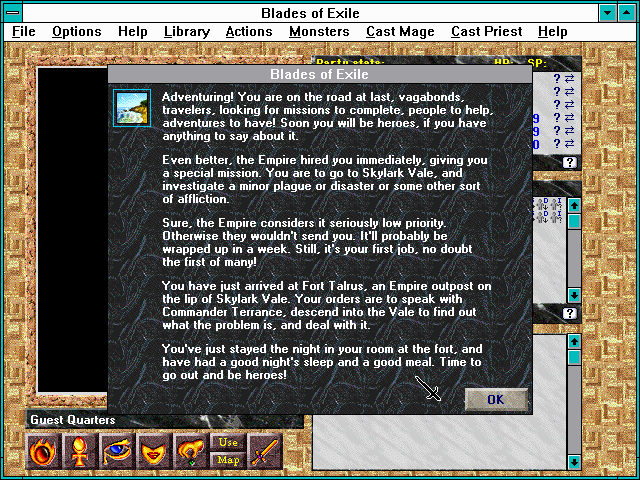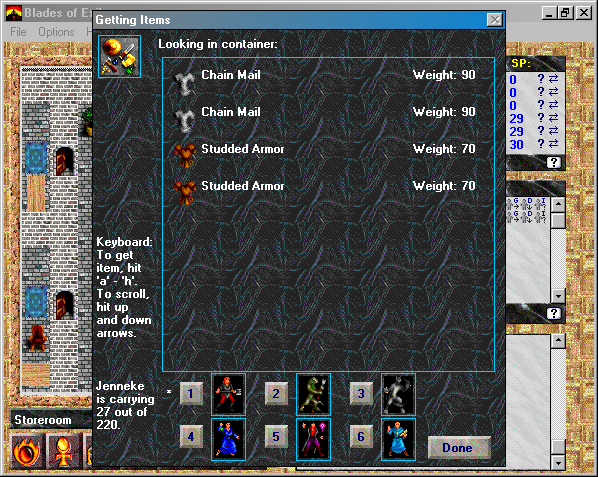Retro Replay Review
Gameplay
At its core, Blades of Exile is less a single, linear adventure and more a robust toolkit for crafting your own Exile epics. Rather than picking up where the previous Exile titles left off, this “final game” in the series hands you the reins, offering an intuitive scenario editor that lets both newcomers and veterans design dungeon layouts, populate maps with monsters and NPCs, and script custom events. The user interface strikes a solid balance between simplicity and depth, streamlining basic tasks like tile placement while still exposing advanced features such as conditional triggers and branching dialogues.
(HEY YOU!! We hope you enjoy! We try not to run ads. So basically, this is a very expensive hobby running this site. Please consider joining us for updates, forums, and more. Network w/ us to make some cash or friends while retro gaming, and you can win some free retro games for posting. Okay, carry on 👍)
The built-in editor empowers creativity with flexible rule sets for combat, magic, and exploration. You can tweak nearly every parameter—from monster AI behavior to the damage curve of your hero’s sword—in real time, then immediately test your creation in a live play session. For players keen on world-building, the ability to import custom graphics and sound effects further enriches the toolkit, enabling truly unique experiences that transcend the stock Exile engine.
Even if you’re less interested in design and more eager for an off-the-shelf adventure, Blades of Exile includes three polished premade scenarios that showcase the editor’s potential. Each scenario varies in scope and difficulty, ranging from a tight, puzzle-driven tomb crawl to an open wilderness expedition filled with hidden side-quests. These ready-made adventures serve both as entertaining diversions and as hands-on tutorials for budding scenario creators.
Graphics
Visually, Blades of Exile sticks to the classic tile-based aesthetic that defined the earlier Exile releases. While its 2D sprites and grid-aligned maps may appear dated compared to modern 3D RPGs, they possess a timeless charm and clarity that veteran fans will appreciate. Character icons, environment tiles, and spell animations are all crisply rendered, making it easy to distinguish terrain features, enemy types, and interactive objects at a glance.
What truly elevates the graphics is the editor’s support for custom art packs. With a few simple steps, creators can swap out the default tiles for bespoke assets, breathing new life into the engine. Whether you’re aiming for a dark gothic fortress or a serene woodland glade, the ability to layer your own artwork lets you achieve a personalized visual identity that stands apart from the three included scenarios.
Furthermore, the map view and combat interface are both highly legible, with clear icons for health bars, spell cooldowns, and status effects. The minimalist HUD keeps the action front and center, while customizable color palettes ensure accessibility for players with color-vision deficiencies. In short, though not cutting-edge, the graphics are functional, charming, and perfectly aligned with the game’s design philosophy.
Story
Because Blades of Exile is primarily a scenario creation suite, it doesn’t deliver a single, overarching narrative in the style of its predecessors. Instead, storytelling is driven by the three included scenarios and the countless user-made modules you can download or craft yourself. This modular approach allows you to experience everything from tightly woven plots about political intrigue to sprawling quests for legendary artifacts.
The first premade scenario is a terse dungeon delve that emphasizes enigmatic lore and environmental puzzles. Its sparse dialogue and cryptic runes invite players to piece together backstory through exploration rather than exposition. The second scenario broadens the scope to an open wilderness, complete with rival factions, hidden treasures, and dynamic weather events that can influence quest outcomes. Finally, the third offering stands out as a narrative-rich mini-campaign, featuring memorable NPCs, branching moral choices, and a satisfying climax that demonstrates the editor’s capacity for cinematic set pieces.
Of course, the most compelling stories may be those you write yourself or discover in the vibrant online community. From dark comedies to epic war sagas, user-generated scenarios span virtually every genre and theme. The game’s built-in scenario browser and community exchange make it easy to find fresh narratives, ensuring that your next great adventure is never far away.
Overall Experience
Blades of Exile caters to two distinct audiences: players who crave customizability and storytellers who want to leave their mark on the Exile universe. For modders and hobbyist designers, it offers depth without unnecessary complexity, making it accessible even if you’ve never wielded a scenario editor before. The learning curve feels organic, with each of the three premade scenarios doubling as practical examples of the editor’s features.
For casual adventurers, Blades of Exile delivers instant playability. The three included quests vary in style and length, ensuring you won’t run out of content while you explore user-made modules. The low system requirements and cross-platform compatibility further broaden its appeal, enabling you to dive in on a modest PC or a lightweight laptop without fuss.
Ultimately, Blades of Exile stands as a fitting finale to the Exile series, shifting the focus from developer-driven storylines to community-driven creativity. Whether you’re looking to craft ambitious campaigns or simply enjoy a rotating roster of fan-made adventures, this game offers enduring value and endless possibilities. As both a sandbox toolkit and a gateway to a thriving modding community, it represents a uniquely flexible RPG experience that few modern titles can match.
 Retro Replay Retro Replay gaming reviews, news, emulation, geek stuff and more!
Retro Replay Retro Replay gaming reviews, news, emulation, geek stuff and more!








Reviews
There are no reviews yet.